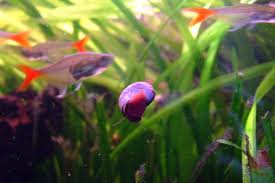





Fish can be an important component of any water feature, although in some of the smaller types they would not be able to survive a cold winter, or even a very warm summer. A substantial volume of cool water can help to sustain animal life but, for the most part, it is the amount of water surface area available that is crucial to the survival of fish. The larger the surface area, the more oxygen is available. In many containers, irrespective of the surface area available, the violent temperature changes that often occur in a small volume of water make it impractical to introduce fish.
 While not essential, fish add considerable visual interest to a small water garden. They cannot do much to bring about a natural balance, but they are extremely useful in controlling aquatic insect pests, especially mosquito larvae. Where it is not possible to keep fish, a small amount of cooking oil dropped on to the water every few weeks prevents the larvae from coming up for air and is harmless to plants. Alternatively you can use mosquito dunks, an import from the United States, to eliminate these pests. These release an innocuous chemical into the water that is nevertheless deadly to the active larvae.
While not essential, fish add considerable visual interest to a small water garden. They cannot do much to bring about a natural balance, but they are extremely useful in controlling aquatic insect pests, especially mosquito larvae. Where it is not possible to keep fish, a small amount of cooking oil dropped on to the water every few weeks prevents the larvae from coming up for air and is harmless to plants. Alternatively you can use mosquito dunks, an import from the United States, to eliminate these pests. These release an innocuous chemical into the water that is nevertheless deadly to the active larvae.
If you are able to include fish in your feature, always select small specimens. Fish are remarkable creatures which are able to adapt to their environment by restricting their growth to the space available. Thus a small goldfish kept in a goldfish bowl for four or five years will be much the same size as when it was first introduced, and will be quite healthy and lively. Once placed in a garden pond, the same goldfish will grow rapidly and can double its size within six months. So it is essential, if your fish are to live a healthy life, that you use small specimens from the outset.
Not all fish, even small ones, will enjoy or tolerate the constraints of a container water feature. Those with high oxygen requirements, such as golden orfe and silver rudd, will quickly perish. Fancy goldfish, especially fantails, veiltails and moors, are the perfect complement, as long as they can be given sanctuary during the winter in cold climates. For the most part, a simple unheated aquarium indoors is sufficient to keep them in good condition all through the winter.
When selecting fish, it is important to choose those that have bright eyes and erect fins, and appear lively and active (although this may be the result of keeping the fish hungry so that they dart about attractively and do not create too much pollution in the dealer’s tank). A clean body without any kind of fungal disease and with all the scales intact is vital; and there should be no sign of constipation from trailing faeces.
Snails can also be introduced to a water feature to some advantage. If you use the ramshorn type, they will keep much of the troublesome filamentous algae under control, especially algae clinging to the inside of the container. Ramshorn snails are round, flat and disc-like, and carry their shells upright on their backs. In very warm conditions they often succumb to the heat, and in heavily populated containers they are sometimes sucked out of their shells by the fish and devoured. Avoid pointed snails or freshwater whelks, which are often sold for water gardens. While it is true that they will eat algae, they will much prefer your prize waterlily.
Fish and snails tend to look after themselves quite well if they have sufficient room and protective plant cover. In a balanced environment there is enough food available naturally for the fish to survive, but in a confined space feeding the fish is essential and fun. Give a good-quality food sparingly three times a week during the summer, never more than the fish can clear up in 20 minutes.
Copyright © www.100flowers.win Botanic Garden All Rights Reserved